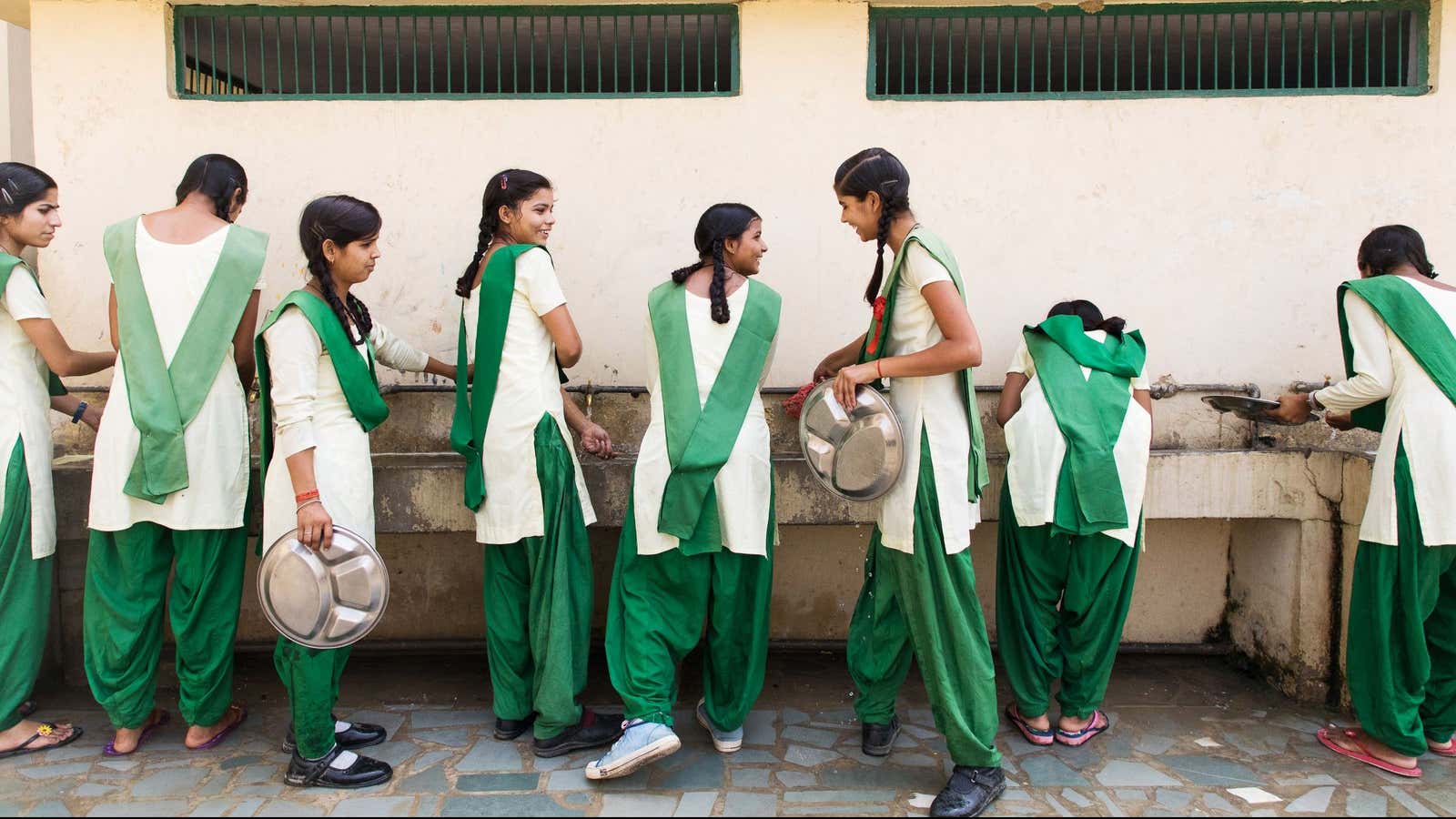Anupshahr, Uttar Pradesh
On most mornings of the year, the better part of 350 million students in India begin their school day with a morning assembly. From kindergarten through twelfth grade, students gather in a hall or a courtyard, recite a prayer, and then the National Pledge, an oath of allegiance to the Republic of India. They listen to important announcements, sing the national anthem, and proceed to their classroom.
The students of Pardada Pardadi Educational Society’s Inter College, an all-girls school, are no exception—but their morning ritual comes with a striking twist. Every morning at 8:25 am, they line up in the hall of the school’s main building, between murals offering reminders that girls are allowed to laugh, and that strength is beauty. Their prayer is an empowering song from an old movie about a warden who rehabilitates six convicts, turning them into farmers. The song’s first verses go like this:
ae maalik tere bande ham
aise hon hamaare karam
neki par chalen
aur badi se talen
taaki hanste huye nikle dam
Oh lord, we are your servants. Make sure that each step we take is honest, and unstoppable… so that we leave this world smiling.
Later, alongside the National Pledge, the girls add another commitment:
Hum zaroor shadi karenge lekin dusvim pure karne ke bad
We will get married, but after completing the tenth grade.
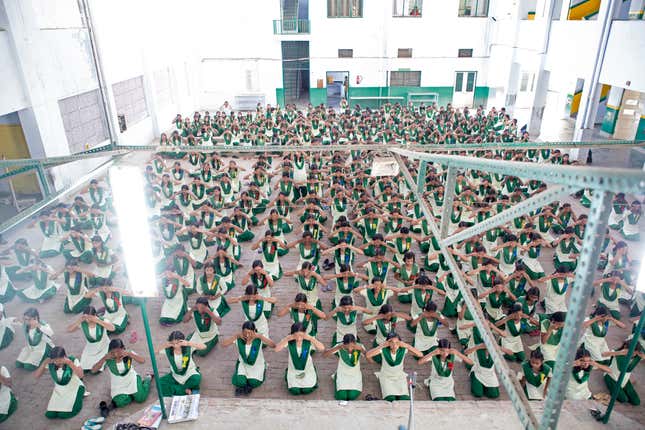
That’s not just an oath the students, ages four to 19, say in the morning—it’s the backbone of their education. It is a significant resolution, given that in rural Uttar Pradesh (UP), at least 54% girls marry before they turn 18.
Since 2000, Pardada Pardadi Educational Society, the organization that runs the school, has educated girls who live below India’s poverty line (below 32 rupees a day per person, or $0.47). For its students, who grow up seeing the women around them at the mercy of men, the school is transformative: They learn not just math and writing, but that girls as well as a boys have a right to freedom and happiness. They learn to believe that the future is theirs.
Families in the region typically cannot afford basic school supplies or spare children who might otherwise help bring in income—and when they can, boys are favored. So not only is the school free of fees, it also provides students with three meals a day, transportation, uniforms, and school supplies. It pays students 10 rupees ($0.15) per day of attendance (15 rupees per day students in tenth through twelfth grade, deposited into an account that can only be accessed once they graduate. This eliminates their need to work in order to save for a dowry, and reduces their likelihood of being married off as children.
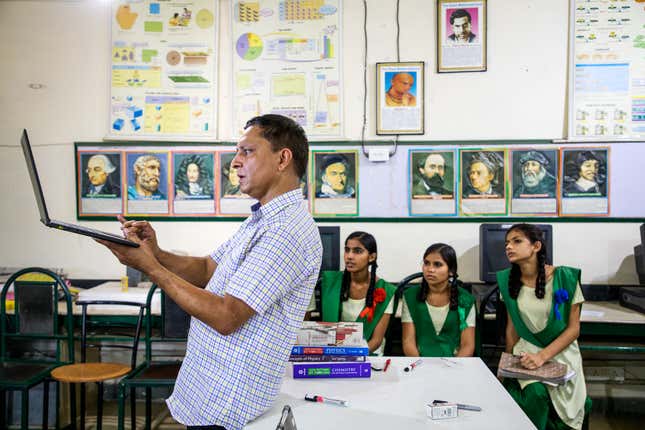
Eighteen years ago, Pardada Pardadi managed to get 45 girls through the door of what was then a brand new, if very spartan, school—two classrooms, for third- and fifth-grade girls. Its original vision was that giving girls an education would eventually lead to financial empowerment, social independence, and respect.
Over the years, Pardada Pardadi has grown in size and scope. It now enrolls 1,400 students a year. The school stands as a tangible example of the “girl effect” theory—which holds that educating girls will change an entire community. There are over 270 million girls and young women under the age of 20 in India, the largest young, female population anywhere in the world. Empowering them means altering the consistent abuse and violence faced by women in India, which currently amounts to the world’s biggest human rights violation.
For Renuka Gupta, the CEO of Pardada Pardadi Educational Society, a crucial component of bringing about that change is “human rights education”—that is, providing students with training in gender equality. For eight hours a day over 14 years, students at the school are relentlessly drilled in the concept conveyed by the oft-repeated motto ladka ladki ek saman: boys and girls are equal. In a country where a girl is called “girl child”—while the preferred children, boys, are in no need of qualifiers—this idea is far from a given.
Human rights as education
Pardada Pardadi isn’t just a grade school. It’s a bastion of feminism in the middle of one of the worst places in India—and the world—to be born a girl.
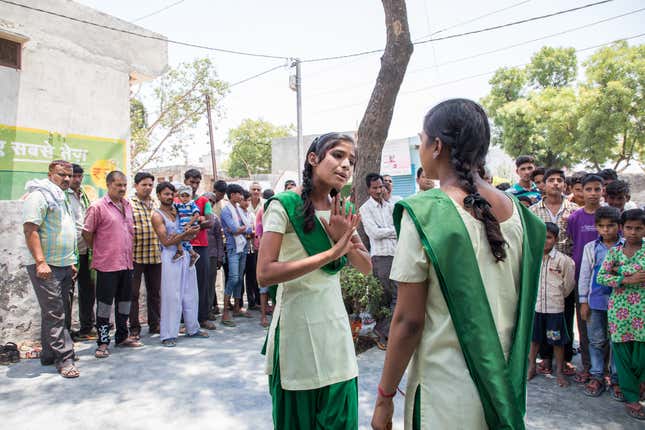
Anupshahr, a town of about 350,000 scattered in dozens of villages, is a polluted, dangerous environment where poverty and violent crime are the norm. There, women routinely suffer unspeakable discrimination and abuse. Women in rural UP have the second-worst life expectancy in India, far below the country’s average 69.6 years (pdf, p.5). Crimes against women in the area have the highest rates in the country, with cruelty inflicted by husbands and other relatives accounting for 34%.
Female illiteracy is widespread in Anupshahr, as it is throughout rural UP. Only a small fraction of women there ever complete the eighth grade.
But inside the school—as signaled by an entrance with a hand-painted sign asking, “Have you loved your daughters today?”—girls are celebrated. By the school bus stop, a painting reminds students to “Dream of Pardada Pardadi.” It features a girl in the school uniform (“First step”), with illustrations of who she might become: a computer scientist, a politician, a doctor, an athlete, a policewoman.
Next to it is a painting shows the Rani of Jhansi, the 19th-century queen of the state of Jhansi (today’s UP)—as she slays an army of men. Above, a statement reads, in Hindi: “History is witness that us women were empowered earlier and are empowered today, too.”
These images and messages are everywhere. Photographs of leading Indian women (such as prime minister Indira Gandhi, or painter Amrita Sher Gil) hang at the entrance. There are paintings made by alumni depicting the lessons they have learned in school; one shows a girl flying out of a cage. A wall of fame features the graduates who went on to attend college, often becoming the first in their families to do so. No opportunity to reinforce the value of education, and of women, is left untaken.
Empowerment in action
The school not only looks different, but feels different from government-run schools catering to poor students in India. Episodes of violence against children committed by school personnel, or cases in which middle-class teachers demonstrate bias against poor students, are unfortunately common, particularly in rural India, explains Archana Dwivedi, the director of Nirantar, a research organization promoting female literacy and empowerment for girls and women.
The school finds a number of ways to ensure that students absorb feminist messages as they go about their school day. Kindergarten play is a way to remind girls to respect one another, and also to celebrate their victories. A first-grade classroom shares great appreciation for the tale of a cuckoo who had a female and male baby, and strived to feed them both equally.
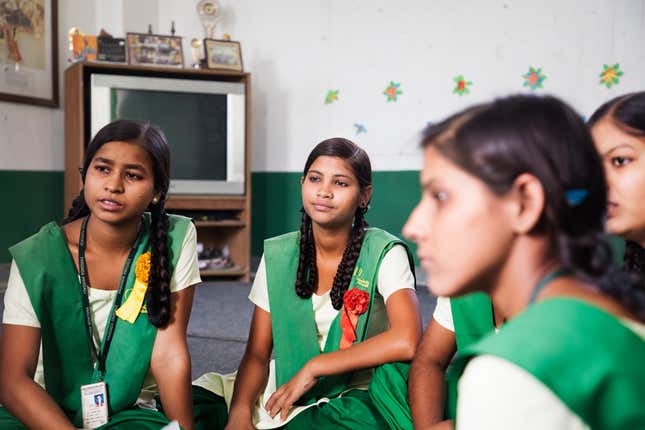
Growing up in an environment permeated with messages of equality and female empowerment has had the effect of cultivating great power in girls, says Gupta. It was this power that changed the school into what it is today.
For the first couple of years, the school functioned as a traditional academic institution in the morning, and as vocational training in the afternoon. But the girls wanted more—they wanted to be able to choose their future, not be set up for one in which they’d toil in workshops. Gupta says she was confronted by girls asking her whether she would be satisfied if her two biological daughters were given as few options as the students of Pardada Pardadi. “[Your biological daughters] can do what they want,” she remembers some of the students asking her, “then why are you discriminating against us? Why don’t you let us choose the life we want?”
For Gupta, it was heartbreaking to hear the students accuse her of not giving them enough opportunities. But it was also a moment of great pride: “These girls wanted to be part of the world’s citizenship,” she said. They had learned to grow their aspirations beyond the limits of their villages and the gendered power dynamics they’d observed through their lives.
This desire was essentially channeled into an expanded curriculum, and has since become the organizing principle of afternoons at Pardada Pardadi. Now girls no longer do needle work, but take on “personality development.” Students learn English and play basketball: The school’s team has won several local tournaments, as Renu, an eleventh grader who is the team captain and like to pursue a career as a coach, proudly brags. They acquire basic digital skills in an area of the world where it’s uncommon for most children to have access to a computer. Girls put on plays that they then perform in their villages, showing families that loving girls and treating them equal to boys results in the advancement of the whole community. The students spread the message that giving girls opportunities isn’t just the right thing to do—it’s smart.
“From here I learned there are a lot of opportunities, and [women] can pursue non-traditional roles,” says Taruna Sharma, one of the school’s first graduates, who now teaches a combination of rhetoric, civil rights, and art during the school’s afternoon sessions. Pardada Pardadi, she says, also taught her that it was not enough to settle for mediocre achievements: “You should show your talent,” she says, “and [strive for] perfection in your work.”

The academic achievements of Pardada Pardadi’s students are remarkable when compared to the surrounding areas. All of them passed the tenth- and twelfth-grade exam, compared to only 85% students in Bulandshahr district and UP in general. Attendance was at 82%, compared to 62% average school attendance for girls in the state. And only 15.4% dropped out, compared to 47.3% of other students in the school’s district.
As of 2017, out of 3,000 admissions, 437 girls have graduated from 10th grade, and 215 have graduated from twelfth grade. Amongst them, 84 have gone on to higher studies, and 72 are employed after completing their college education. Girls from the school also have a fertility rate between the ages 16-30 of 1.08 children, compared to 1.63 children average for young women of the area. Many have gone on to become nurses, computer scientists, and yoga teachers—better jobs than the rest of their families could dream of. They send money home.
Even amongst the graduates who didn’t pursue further studies, 18.5% of Pardada Pardadi graduates earn a regular monthly income, compared to just 5.6% of the general female population.
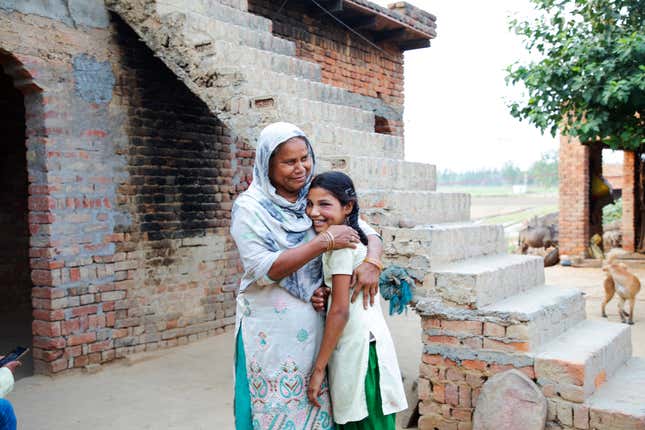
Many girls around Anupshahr, and even some of the school’s students, still face challenges that prevent them from attending or excelling at the school—a new sibling to look after, say, or a father who still thinks it’s not proper for a girl to ride a bicycle to school.
But by and large, Pardada Pardadi has changed the community’s perception of what girls can and should achieve. Early on, the staff struggled to find those 45 girls to attend the school. It also had to prove that there was no hidden money-making scheme behind opening the school. Now, it has the opposite problem: Too many parents apply every year, hoping their girls, too, may change their (and their families’) destiny. Currently, the school is only accepting applications within a 15km radius of the school. Soon, the organization hopes to raise the $4 million he needs to double out the size of the school, enrolling up to 3,000 girls in total per year.
Gupta thinks this is a model that could be exported everywhere—no matter how rich the country or the school. “My vision is that this model could be replicated across the world,” she says. Anywhere in the world, there is power to be unleashed in a girl who knows not just her numbers and letters, but her own worth.
This story was reported with the support of the Pulitzer Center on Crisis Reporting.
